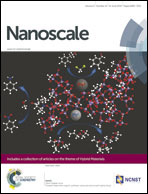Solid-state nanopores and nanopore arrays optimized for optical detection†
Abstract
While conventional solid-state nanopore measurements utilize ionic current, there is a growing interest in alternative sensing paradigms, including optical detection. However, a limiting factor in the application of optical schemes in particular is the inherent background fluorescence created by the solid-state membrane itself, which can interfere with the desired signal and place restrictions on the fluorophores that can be employed. An ideal device would incorporate a localized reduction in membrane fluorescence using a method that can be integrated easily with the nanopore fabrication process. Here, we demonstrate that in addition to forming nanopores and nanopore arrays, a focused helium ion beam can be used to reduce the fluorescence of a conventional silicon nitride membrane controllably. The reduction in background produces low-fluorescence devices that can be used for optical detection of double-strand DNA, as well as for conventional resistive pulse sensing. This approach is used to identify the translocation of short single-strand DNA through individual nanopores within an array, creating potential for a massively-parallel detection scheme.


 Please wait while we load your content...
Please wait while we load your content...